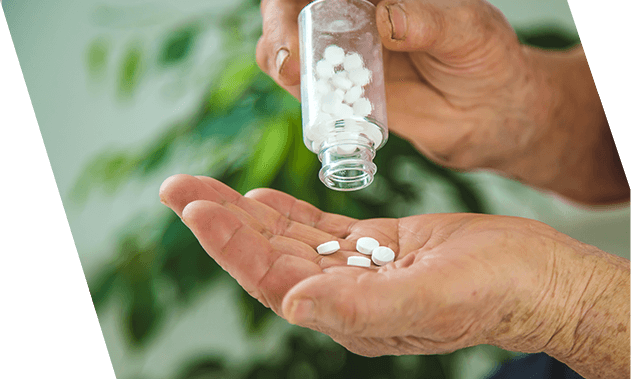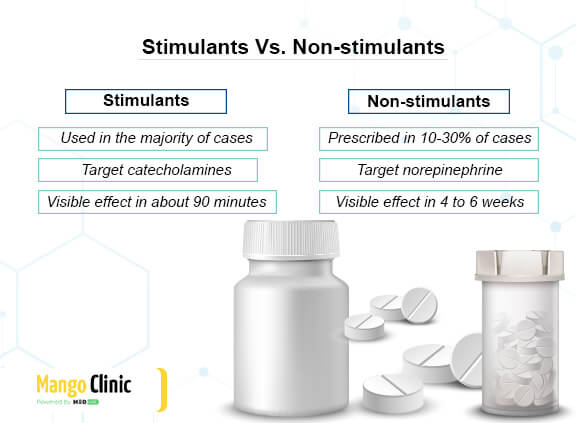How Stimulants and Non-stimulants Work for ADHD

Stimulants and non-stimulants are the two main categories of ADHD medication. Although they have different pharmacodynamics, their effectiveness is the same, and it’s not uncommon to switch between them.
Stimulants have been used for ADD and ADHD treatment since the 1960s and have proven efficacy for the majority of patients with this condition. The most commonly prescribed brands include Adderall, Focalin, Vyvanse, Dexedrine, and Ritalin. On the other hand, non-stimulant drugs for ADHD are a newer option. For example, Atomoxetine (also known as Strattera) has been used since 2002. Other types of non-stimulant medications include tricyclic antidepressants, non-tricyclic antidepressants, alpha-2 noradrenergic agonists, specific norepinephrine reuptake inhibitors, etc.
Still, the period of use is just one aspect, and if you want to learn more about the difference between stimulants and non-stimulants and how they work, keep reading!
If you experience ADHD symptoms, book an appointment to get a personalized treatment plan.
How Stimulant and Non-Stimulant Medications Work
Stimulants are commonly prescribed for ADHD treatment as they target catecholamines (dopamine, norepinephrine, and epinephrine) — brain chemicals that are involved in many processes in our bodies. Among other functions, it helps people to be motivated and to be able to finish tasks. It can also aid in regulating behavior patterns and emotions better.
Non-stimulants target norepinephrine by blocking its reuptake in the brain. As a result, it improves memory, helps to control emotions better and to focus on completing tasks in ADHD patients. Non-stimulants are used in 10-30% of the cases where stimulants fail to control ADHD symptoms or have severe side effects.
Switching from Stimulants to Non-stimulants
It is not unusual that patients with ADHD are switched from one type of medication to another. The reasons may include experiencing side effects or not achieving the desired goals in the set period of time. There are several ways to switch between different drugs safely but all of them require a patient to provide a detailed health history.
However, sometimes, changing the dosage of the same medication can be a helpful solution. For some patients, there is a need to fine-tune the medicine dosage, possibly more than once. It often takes several weeks to determine the right dose and timing. But if those changes aren’t adequate, your doctor may decide whether it makes sense to switch ADHD medications.

For example, there are different reasons for Adderall or another stimulant not working, so always consult your doctor on the changes. You may be recommended to consider switching from Adderall to Strattera or will be provided with other options.
How Well Do Non-stimulants Work for ADHD?
Some patients respond very well to non-stimulants and notice increased focus while stimulants don’t influence their symptoms. One important thing to know is that the results of the treatment become visible in 4 to 6 weeks, so there is no reason to choose another medication earlier. Still, about 50 percent of people taking these drugs don’t benefit from them at all.
Non-stimulant ADHD meds can work in different dosages. Problems may arise at the stage of withdrawal. For instance, if a person has been prescribed a low dose of a non-stimulant, they can stop taking it at once after consulting with a doctor. But if the dose has been rising over time to a high level, the withdrawal must be held gradually, so as to avoid problems and harmful effects. The process of tapering off non-stimulant medication normally takes several weeks.
Do you suppose your medications don’t work? Consult with our online doctors to adjust your treatment plan.
Common Side Effects of Stimulants
Stimulants are effective in improving attention and reducing hyperactivity and impulsiveness. They are short-acting and start working in up to 90 minutes of taking the first dose. But people react to medications differently because of their individual sensitivity, and such a speed also means that if you are going to have side effects, they will be noticed quickly too.
| Common Side Effects | Rare Side Effects |
| Loss of appetite | Headaches |
| Trouble sleeping | Increased anxiety |
| Irritability | Agitation |
| Dry mouth | Tics |
| Increased heart rate | Psychosis |
Common Side Effects of Non-stimulant Medication for ADHD
The decision about stimulants vs non-stimulants is often based on the information about side effects too. And although the latter type helps to deal with the symptoms of inattentiveness, impulsivity, and hyperactivity, they can also come with more side effects than stimulants.
For example, Atomoxetine (Strattera) may cause moodiness, sluggishness, nausea, and decreased appetite. Another kind of non-stimulant, alpha-2 adrenergic, may cause sleepiness, fatigue, nausea, appetite loss, and blood pressure drop.

The Bottom Line
Stimulants and non-stimulants are the first-line treatment for ADHD. They have different algorithms of work and target different kinds of brain chemicals, their equality is in helping patients reduce ADHD symptoms. It is also not uncommon to switch from stimulants to non-stimulants because of side effects or ineffectiveness. Still, sometimes just changing the dose helps too.
Always consult a mental health specialist to learn how stimulants and non-stimulant medications will work in your particular case and follow the given guidelines. Contact us today to get a personalized treatment plan for ADHD and have a smooth prescription management process.









